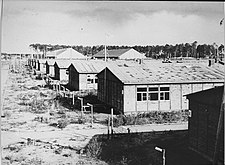Our website is made possible by displaying online advertisements to our visitors.
Please consider supporting us by disabling your ad blocker.
Stutthof concentration camp
| Stutthof | |
|---|---|
| Nazi concentration camp | |
 Prisoner barracks after liberation | |
| Coordinates | 54°19′44″N 19°09′14″E / 54.32889°N 19.15389°E |
| Location | Sztutowo |
| Operated by | German government |
| Commandant | Max Pauly, September 1939 – August 1942 Paul-Werner Hoppe, August 1942 – January 1945 |
| Operational | 2 September 1939 – 9 May 1945 |
| Inmates | Poles, Jews, and political prisoners of various nationalities |
| Number of inmates | 110,000 |
| Killed | 63,000 - 65,000 (including 28,000 Jews) |
| Liberated by | Red Army |

Stutthof was a Nazi concentration camp established by Nazi Germany in a secluded, marshy, and wooded area near the village of Stutthof (now Sztutowo) 34 km (21 mi) east of the city of Danzig (Gdańsk) in the territory of the German-annexed Free City of Danzig. The camp was set up around existing structures after the invasion of Poland in World War II and initially used for the imprisonment of Polish leaders and intelligentsia.[1][2] The actual barracks were built the following year by prisoners.[3] Most of the infrastructure of the concentration camp was either destroyed or dismantled shortly after the war. In 1962, the former concentration camp with its remaining structures was turned into a memorial museum.[4]
Stutthof was the first German concentration camp set up outside German borders in World War II, in operation from 2 September 1939. It was also the last camp liberated by the Allies, on 9 May 1945. It is estimated that between 63,000 and 65,000 prisoners of Stutthof concentration camp and its subcamps died as a result of murder, starvation, epidemics, extreme labour conditions, brutal and forced evacuations, and a lack of medical attention. Some 28,000 of those who died were Jews. In total, as many as 110,000 people were deported to the camp in the course of its existence. About 24,600 were transferred from Stutthof to other locations.[3]
- ^ Cite error: The named reference
Blatmanwas invoked but never defined (see the help page). - ^ Maria Przyłucka (1977). Praca więźniów w obozie koncentracyjnym Stutthof [Prisoner labour at Stutthof] (PDF). Muzeum Stutthof w Sztutowie. p. 59 (4–5/19 in PDF). Retrieved 11 February 2015.
- ^ a b Stutthof State Museum. "History of the concentration camp in Stuttfof" [Obóz koncentracyjny Stutthof (1939-1945)] (in Polish). Sztutowo, Poland. Archived from the original on 22 March 2016.
- ^ "The Stutthof Museum in Sztutowo". Pomorskie.travel. Retrieved 30 September 2021.
Previous Page Next Page



